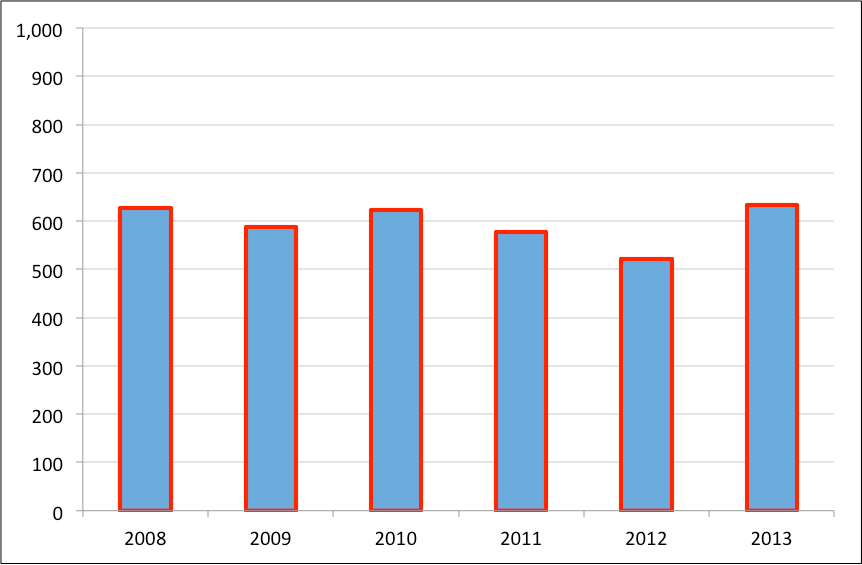Enrolled Patient Numbers
Randomized Clinical Trials (RCTs) have constituted the foundation for new drug approvals for over fifty years.
Randomized Clinical Trials (RCTs) have constituted the foundation for new drug approvals for over fifty years. An Institute of Medicines (IOM) report concluded though in 2008 that RCTs may become unsustainable because of the time and expense involved. In addition, as therapies become more targeted, the financial calculus may make these RCTs even more problematic.
Some industry critics have argued that the increasing number of patients in Phase III clinical trials is actually an industry strategy to improve the statistical strength of clinical trial results and RCTs will actually have to continue to increase in size. As differences between active and non-active arms become more difficult to establish, larger sample sizes are used to improve the chances of reporting statistically significant differences.1 Rather than a response to scientific necessity, the growing number of enrolled patients is a conscious strategy to improve the chances of a favorable regulatory approval decision.
ClinicalTrials.gov reports the actual number of targeted enrolled patients. ClinicalTrials.gov is a federally mandated database with a large, and growing, number of mandatory data fields. One of these mandated fields is number of patients. Another is therapeutic area. These data fields are particularly robust, with missing data under three percent. ClinicalTrials.gov requires that information be reported for any study operating under the auspices of the FDA. This analysis examines Phase III studies conducted by commercial pharmaceutical companies.
The average number of enrolled patients has not changed since 2008 when the enrolled patients variable became mandatory. Only one MedRHA therapeutic area--vascular disorders--shows a statistically significant difference from the overall results for the six years covered by the analysis. However, the number of patients has actually declined over the period in question.
1Adrian G. Sacher, Lisa W. Le, Natasha B. Leighl. Shifting patterns in the interpretation of phase III clinical trial outcomes in advanced non-small-cell lung cancer: the bar is dropping. Journal of Clinical Oncology. March 2014.
Average Patient Enrollment per Phase III Study by Year

Source: Department of Health Policy and Public Policy, University of the Sciences, Philadelphia, PA
Improving Relationships and Diversifying the Site Selection Process
April 17th 2025In this episode of the Applied Clinical Trials Podcast, Liz Beatty, co-founder and chief strategy officer, Inato, discusses a number of topics around site engagement including community-based sites, the role of technology in improving site/sponsor relationships, how increased operational costs are impacting the industry, and more.
Behind the Buzz: Why Clinical Research Leaders Flock to SCOPE Summit
February 7th 2025In this episode, we meet with Micah Lieberman, Executive Conference Director for SCOPE Summit (Summit for Clinical Ops Executives) at Cambridge Innovation Institute. We will dive deep into the critical role of collaboration within the clinical research ecosystem. How do we bring together diverse stakeholders—sponsors, CROs, clinical trial tech innovators, suppliers, patients, sites, advocacy organizations, investors, and non-profits—to share best practices in trial design, program planning, innovation, and clinical operations? We’ll explore why it’s vital for thought leaders to step beyond their own organizations and learn from others, exchanging ideas that drive advancements in clinical research. Additionally, we’ll discuss the pivotal role of scientific conferences like SCOPE Summit in fostering these essential connections and collaborations, helping shape the future of clinical trials. Join us as we uncover how collective wisdom and cross-industry partnerships are transforming the landscape of clinical research.
FDA-Approved Gene Therapy Beqvez Shows Sustained Efficacy, Safety in Long-Term Hemophilia B Trial
April 17th 2025Beqvez (fidanacogene elaparvovec), an FDA-approved one-time gene therapy for hemophilia B, demonstrated sustained factor IX expression, low bleeding rates, and a favorable safety profile over long-term follow-up.